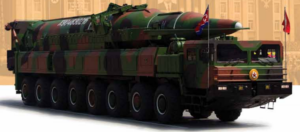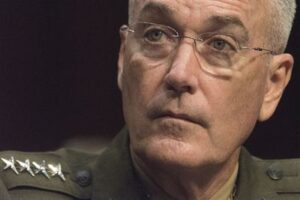
Vice Chairman of the Joint Chiefs Gen. Paul Selva
WASHINGTON: North Korea has cut the warning time America has to a “dozen minutes or so” before an ICBM launch because of the mobile launch trucks it’s using, according to the Vice Chairman of the Joint Chiefs.
“We may have gone from tens of minutes to up to an hour (previously) to a dozen minutes or so of indications and warning if we’re lucky,” Gen. Paul Selva told the Defense Writers Group this morning.
Combine that with North Korea’s excellent camouflage techniques, putting many of its nuclear and rocket technologies in tunnels or underground, and its careful tracking of American spy satellites, and the time we have to prepare for an imminent launch has shrunk.

North Korean road-mobile missile launcher
Note that those truck launchers (a missile transporter-erector-launcher known as a TEL) were sold by China to the North as lumber transporters. We’re sure China was shocked, shocked when Kim converted them back to missile launchers.
Selva said North Korean leader Kim Jong-Un does not yet have the ability to strike the United States with a nuclear warhead on an ICBM. Selva didn’t address the issue of range or the payload capacity of the rocket and was very careful about what he told reporters, noting how much of this information is classified.
“What he has not demonstrated yet are the fusing and targeting technologies and survivable re-entry vehicle,” Selva said. “It is possible he has them, so we have to place the bet that he might have them, but he hasn’t demonstrated them.”
As Breaking D readers know, simply launching a true ICBM does not prove you can mount a nuclear warhead on it complete with the guidance and targeting technology necessary. “To my knowledge a reentry cannot be tested underground to test the stresses involved.”

The military’s geographical Combatant Commands (COCOMs).
Global Command & Control
In the long term, perhaps the most important thing Selva spoke about was both brief and a bit cryptic.
Pointing to the new National Defense Strategy, he said the way we organize to fight will change. The chairman of the Joint Chiefs will become a “global integrator” and “be responsible for providing the characterization of risk to the secretary and the president. Right now the combatant commanders do that independent of one another, and we’re left with the task of taking disparate opinions from them and sort of kludging them together to present to the president.”
Enabling the Joint Staff to do that will require the Pentagon do a “more robust” central assessment of readiness and just where are forces are located.

Gen. Joseph Dunford, Chairman of the Joint Chiefs of Staff
It will also require the chairman “to aggregate that information together and present it to the secretary and the president In real time, the risks they are assuming by the posture and position and the readiness of those forces.” Selva said today we rely on each service to provide that information. Also, we do “very little in the way of predictive analytics” on the readiness of forces in the future instead of the past “and where you might want to put them to mitigate risks that are extant and emerging.”
Right now, any conflict with Russia is managed by European Command, although a conflict with Russia would involve at least seven of the global combatant commands.
Also, you’re going to see what Selva called “global campaign plans” will be built to cope with the two great powers identified in the National Defense Strategy, China and Russia. “A global combatant commander will become the coordinating authority for that plan.”
He also said the recently published National Military Strategy will be revised in at least six months because of the great power competition changes made manifest in the National Defense Strategy.
Best line of the breakfast: “Wouldn’t it be cool if we could shoot someone in the face at 200 kilometers? They don’t even know you’re there.” Selva was talking about advanced technology, including artificial intelligence and man-machine teaming on an aircraft that could allow a pilot to kill the enemy with “high confidence” at long ranges and high speeds.
In a ‘world first,’ DARPA project demonstrates AI dogfighting in real jet
“The potential for machine learning in aviation, whether military or civil, is enormous,” said Air Force Col. James Valpiani. “And these fundamental questions of how do we do it, how do we do it safely, how do we train them, are the questions that we are trying to get after.”


























